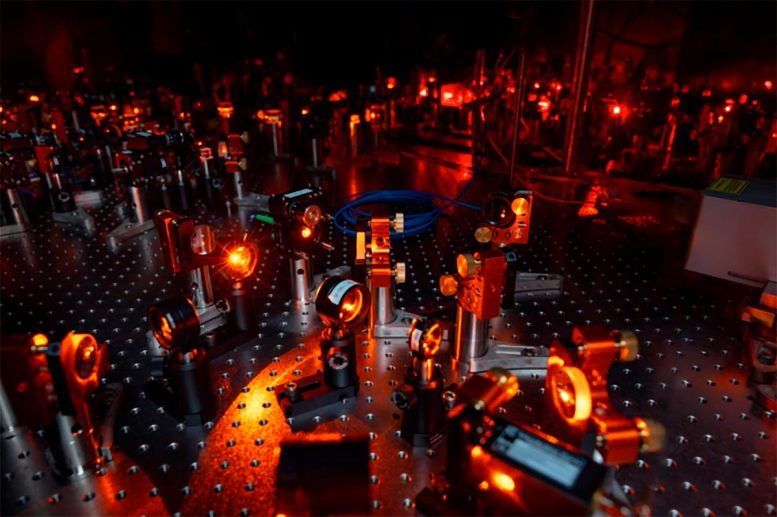
A team of Princeton physicists has achieved a breakthrough in quantum mechanics by entangling individual molecules. This research opens up new possibilities for quantum computing, simulation, and sensing. The team’s innovative use of optical tweezers to control molecules overcomes previous challenges in quantum entanglement, signaling a significant advancement in the field. Credit: SciTechDaily.com
In work that could lead to more robust quantum computing, Princeton researchers have succeeded in forcing molecules into quantum entanglement.
For the first time, a team of Princeton physicists has been able to link together individual molecules into special states that are quantum mechanically “entangled.” In these bizarre states, the molecules remain correlated with each other—and can interact simultaneously—even if they are miles apart, or indeed, even if they occupy opposite ends of the universe. This research was published in the journal Science.
Molecular Entanglement: A Breakthrough for Practical Applications
“This is a breakthrough in the world of molecules because of the fundamental importance of quantum entanglement,” said Lawrence Cheuk, assistant professor of physics at Princeton University and the senior author of the paper. “But it is also a breakthrough for practical applications because entangled molecules can be the building blocks for many future applications.”
These include, for example, quantum computers that can solve certain problems much faster than conventional computers, quantum simulators that can model complex materials whose behaviors are difficult to model, and quantum sensors that can measure faster than their traditional counterparts.

Laser setup for cooling, controlling, and entangling individual molecules. Credit: Richard Soden, Department of Physics, Princeton University
“One of the motivations in doing quantum science is that in the practical world it turns out that if you harness the laws of quantum mechanics, you can do a lot better in many areas,” said Connor Holland, a graduate student in the physics department and a co-author on the work.
The ability of quantum devices to outperform classical ones is known as “quantum advantage.” And at the core of quantum advantage are the principles of superposition and quantum entanglement. While a classical computer bit can assume the value of either 0 or 1, quantum bits, called qubits, can simultaneously be in a superposition of 0 and 1. The latter concept, entanglement, is a major cornerstone of quantum mechanics, and occurs when two particles become inextricably linked with each other so that this link persists, even if one particle is light years away from the other particle. It is the phenomenon that Albert Einstein, who at first questioned its validity, described as “spooky action at a distance.” Since then, physicists have demonstrated that entanglement is, in fact, an accurate description of the physical world and how reality is structured.
Challenges and Advances in Quantum Entanglement
“Quantum entanglement is a fundamental concept,” said Cheuk, “but it is also the key ingredient that bestows quantum advantage.”
But building quantum advantage and achieving controllable quantum entanglement remains a challenge, not least because engineers and scientists are still unclear about which physical platform is best for creating qubits. In the past decades, many different technologies—such as trapped ions, photons, superconducting circuits, to name only a few—have been explored as candidates for quantum computers and devices. The optimal quantum system or qubit platform could very well depend on the specific application.
Until this experiment, however, molecules had long defied controllable quantum entanglement. But Cheuk and his colleagues found a way, through careful manipulation in the laboratory, to control individual molecules and coax them into these interlocking quantum states. They also believed that molecules have certain advantages—over atoms, for example—that made them especially well-suited for certain applications in quantum information processing and quantum simulation of complex materials. Compared to atoms, for example, molecules have more quantum degrees of freedom and can interact in new ways.
“What this means, in practical terms, is that there are new ways of storing and processing quantum information,” said Yukai Lu, a graduate student in electrical and computer engineering and a co-author of the paper. “For example, a molecule can vibrate and rotate in multiple modes. So, you can use two of these modes to encode a qubit. If the molecular species is polar, two molecules can interact even when spatially separated.”
Nonetheless, molecules have proven notoriously difficult to control in the laboratory because of their complexity. The very degrees of freedom that make them attractive also make them hard to control, or corral, in laboratory settings.
Innovative Experimental Techniques and Future Prospects
Cheuk and his team addressed many of these challenges through a carefully thought-out experiment. They first picked a molecular species that is both polar and can be cooled with lasers. They then laser-cooled the molecules to ultracold temperatures where quantum mechanics takes centerstage. Individual molecules were then picked up by a complex system of tightly focused laser beams, so-called “optical tweezers.” By engineering the positions of the tweezers, they were able to create large arrays of single molecules and individually position them into any desired one-dimensional configuration. For example, they created isolated pairs of molecules and also defect-free strings of molecules.
Next, they encoded a qubit into a non-rotating and rotating state of the molecule. They were able to show that this molecular qubit remained coherent, that is, it remembered its superposition. In short, the researchers demonstrated the ability to create well-controlled and coherent qubits out of individually controlled molecules.
To entangle the molecules, they had to make the molecule interact. By using a series of microwave pulses, they were able to make individual molecules interact with one another in a coherent fashion. By allowing the interaction to proceed for a precise amount of time, they were able to implement a two-qubit gate that entangled two molecules. This is significant because such an entangling two-qubit gate is a building block for both universal digital quantum computing and for simulation of complex materials.
The potential of this research for investigating different areas of quantum science is large, given the innovative features offered by this new platform of molecular tweezer arrays. In particular, the Princeton team is interested in exploring the physics of many interacting molecules, which can be used to simulate quantum many-body systems where interesting emergent behavior such as novel forms of magnetism can appear.
“Using molecules for quantum science is a new frontier and our demonstration of on-demand entanglement is a key step in demonstrating that molecules can be used as a viable platform for quantum science,” said Cheuk.
In a separate article published in the same issue of Science, an independent research group led by John Doyle and Kang-Kuen Ni at Harvard University and Wolfgang Ketterle at the Massachusetts Institute of Technology achieved similar results.
“The fact that they got the same results verify the reliability of our results,” Cheuk said. “They also show that molecular tweezer arrays are becoming an exciting new platform for quantum science.”
Reference: “On-demand entanglement of molecules in a reconfigurable optical tweezer array” by Connor M. Holland, Yukai Lu and Lawrence W. Cheuk, 7 December 2023, Science.
DOI: 10.1126/science.adf4272
The work was supported by Princeton University, the National Science Foundation (Grant No. 2207518), and the Sloan Foundation (Grant No. FG-2022-19104).









According to topological vortex gravitational field theory, stars and radioactive elements are highly active topological vortex nodes in the universe. Forming controllable entanglement with these nodes may provide many possibilities for the future of human science.
You guys are great. Good luck to everyone.
We heard of tossing a Coin and lacking head or tail, when observed while in air. But, What about tossing an empty metallic cube with heads and tails drawn all over on all of its sides? How messy can it be to know which complex it has while in focus, while the Cube is still in the air?
if an atom in one of the entangled molecules decays radioactively, then does the entangled molecules also decay at the same time? Or does non-decaying force the other entangled molecule NOT to decay?
According to the theory of topological vortex gravitational field, the interaction and balance of topological vortices are the basis for the evolution of the motion of everythings in the universe. The physical essence of quantum entanglement is vortex entanglement and gravitational entanglement. Each topological vortex is essentially a quantum clock. The spin of topological vortices dominates the evolution of spacetime matter.
The so-called academic journals (such as Physical Review Letters, Proceedings of the National Academy of Sciences, Nature, Science, etc.) adhere to pseudoscientific ideas and are stubborn.
Shorter laser pulse production and more accurate atomic structure require correct theoretical guidance.
If you don’t want to be fooled by their pseudoscientific ideas, you can browse the comments of https://scitechdaily.com/microscope-spacecrafts-most-precise-test-of-key-component-of-the-theory-of-general-relativity/ or https://zhuanlan.zhihu.com/p/595280873.
I hope more people dare to stand up and fight against rampant pseudoscience.
Wishing you the best.
I’ve compared the “delayed choice” in the “delayed choice quantum eraser” to blocking a slit from the back, instead of blocking the slit from the front or in-line blocking, another example of me wanting to take all the physics perma-rent-seeking gravitas/mystique out of two slits. Noticed many people questioning the gravitas of delayed choice rent-seeking gravitas/mystique after that.
Interference between molecules with the slits is simply the next spookiness-inducing magic gimmick. Electrons, atoms and molecules can naturally be induced to magnetically pair up in complementary states and generate experimental “signal drop-out” and ambient noise avoidance as composite bosons without sharing the space of a single electron, atom or molecule.
True superposition may be allowed with particles of light (true fundamental bosons – photons) because these particles are massless. A photon with the E-field pointing up can be perfectly superimposed over a photon with the E-field pointing down.
I bring these things up because so many gravity theory rent-seekers are back to ignoring working quantum gravitometers, and insisting various perfectly dubious things about superpositions involving billions of atoms in a pair of diamonds.
“superpositions involving billions of atoms in a pair of diamonds”
It’s described as “levitation” but of course they don’t explain it in terms of two facets stuck together by vacuum energy shielding (Casimir effect). Not seeing a solid link between carbon atoms in easily-flattened buckyball interferences and interference between carbon atoms embedded within diamonds. Apparently classical gravity thought leaders demand a lack of local realism to feel comfortable while seeking rent.
I doubt they will they spin their diamonds at equally high rates on a common spin axis. I’m sure they’ll never bring up cold nucleonic retroreflection of gravitational information flows, or the rough diamondlike shapes of Bennu and Ryugu, because that would be a basis for redirecting funding to someone else in particular.